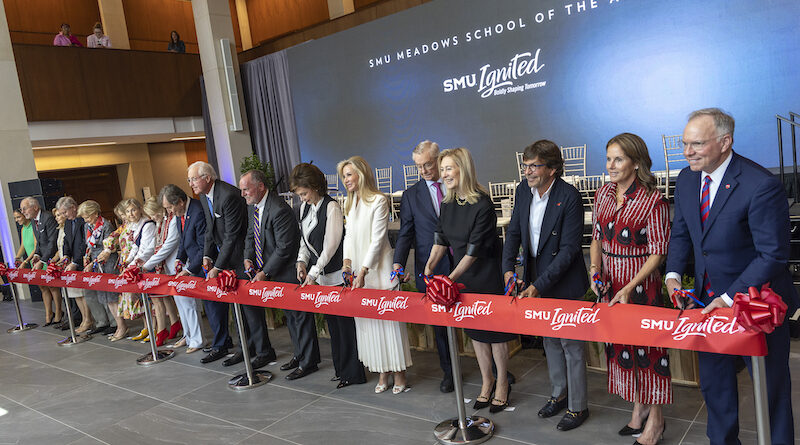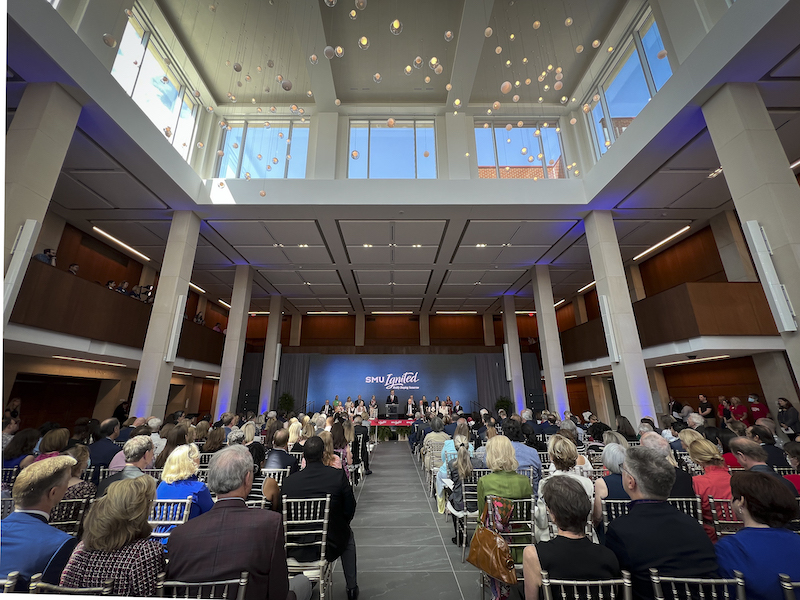SMU Celebrates Dedication of Meadows School Visual Arts Complex
The SMU Meadows School of the Arts celebrated the dedication of its enhanced visual arts facilities Sept. 16.
“At SMU, we believe that inspired minds create an inspiring world,” said R. Gerald Turner, SMU president. “The improvements our donors have made possible will ignite the creative capacities of students as they hone their artistic skills and forge new avenues of educational opportunity and creative thinking.”
The $34 million redesign, announced in 2019, supports the major goals of SMU Ignited: Boldly Shaping Tomorrow, the University’s multiyear $1.5 billion campaign for impact.
“The Meadows Foundation has proudly supported the SMUMeadows School of the Arts since its establishment when Al Meadows saw its potential to impact the future,” said Peter M. Miller, The Meadows Foundation president and chief executive officer. “Beautiful buildings like this reflect the creativity of our community and our state. They spark curiosity and nurture imagination for generations.”
The school’s renovated facilities boast several indoor and outdoor spaces that welcome visitors to the center:
- The Gene and Jerry Jones Grand Atrium and Plaza acts as the center’s grand east entrance and provides an enclosed space for formal and impromptu student performances, concerts, and events.
- The Rogers North Entrance is the external access point for visitors and students to the new Nancy C. and Richard R. Rogers Center for Visual Arts, which serves as the north wing of the visual arts facilities.
- The Sexton Family Courtyard greets those approaching from Hillcrest Avenue to the west and acts as the main entrance for the Greer Garson Theatre, Margo Jones Theatre and the Hamon Arts Library.
- The Paul W. Harris Promenade, funded by the Hoblitzelle Foundation, runs alongside the entirety of the visual arts facilities and serves as the central campus connection to the arts facilities’ new north entrance.
In addition, the facilities offer several updated and renovated educational and administrative spaces where students can utilize technology and collaborate or create independently, including the Sexton Family Art Studio and Terrace, the Sexton Family Suite for Creative Computation, and the Mark S. Moussa Foundations Studio.
The Sewell Family Suite for the Algur H. Meadows Dean will provide student support services, while the Moody Foundation Gallery Conference Room is equipped for meetings with distinguished guests of the University and for faculty/student presentations and seminars.
The visual arts facilities also house multiple galleries for exhibitions, including the William B. Jordan Gallery, named in honor of the founding director of the Meadows Museum, and The Meadows Foundation Gallery.
“This project was not only a labor of love, but also a commitment to excellence and to our students,” said Samuel S. Holland, Algur H. Meadows Dean of the Meadows School of the Arts. “Our expanded and improved facilities will enable new creative breakthroughs, inspire groundbreaking artistic innovations and promote artistic collaboration across our programs.”
SMU’s performing and visual arts complex has been home to the Meadows School of the Arts since its inception over 50 years ago. Located at the heart of the SMU campus between Bishop Boulevard and Hillcrest Avenue, the school’s initial facilities were designed in the 1960s by noted architect George Dahl. When it opened, the original Owen Arts Center included the Forbes Music Building, the Mudge Art Building and the Sharp Drama Building. Over subsequent decades, it has been expanded into an integrated complex, including the Garson Theatre and the Hamon Arts Library. Several rehearsal and performance facilities, teaching classrooms, studios and faculty offices, all made possible by numerous donors, complete the complex.
“These facilities further strengthen the Meadows School of the Arts as a premier artistic and cultural institution,” said Brad E. Cheves, SMU vice president for Development and External Affairs. “Through their generosity and passion for the mission at Meadows, our donors are building a new foundation for the future of art education and cultural research on the Hilltop, and we are grateful for their dedication.”
Visit the project page for the Meadows facilities’ transformation to learn more about this project and to view the full list of its donors.











